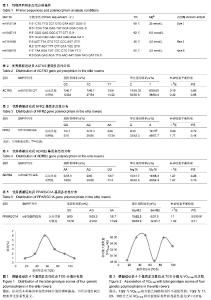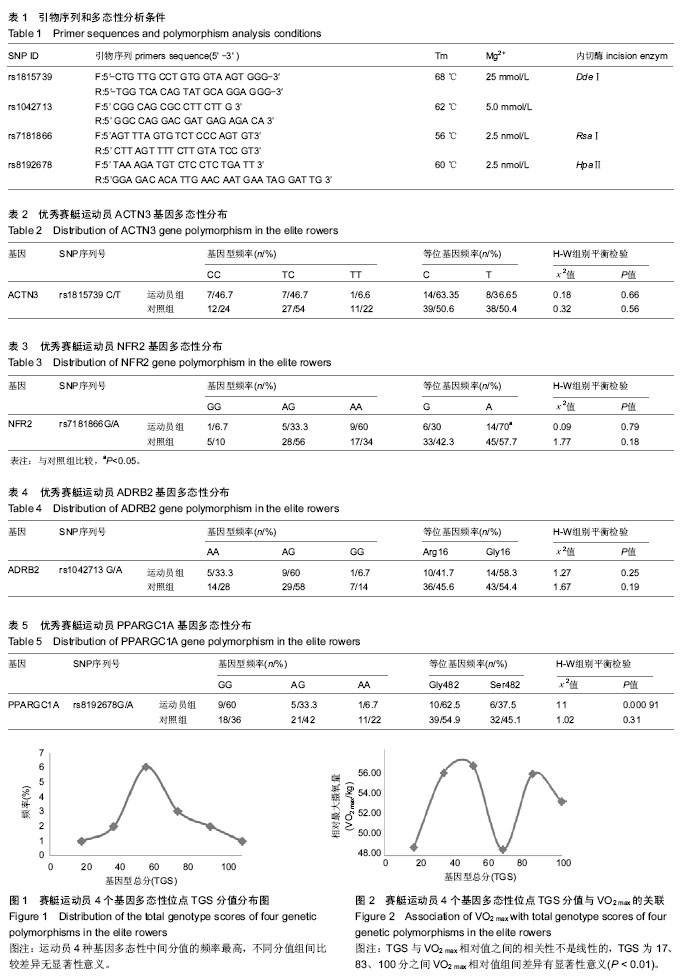Chinese Journal of Tissue Engineering Research ›› 2018, Vol. 22 ›› Issue (16): 2508-2513.doi: 10.3969/j.issn.2095-4344.0863
Previous Articles Next Articles
Correlation of four gene polymorphic loci with athlete endurance phenotype
Wei Qi, Fan Jia-cheng, Du Ya-wen
- Hubei Institute of Sports Science, Wuhan 430205, Hubei Province, China
-
Received:2018-01-19Online:2018-06-08Published:2018-06-08 -
About author:Wei Qi, Master, Associate researcher, Hubei Institute of Sports Science, Wuhan 430205, Hubei Province, China -
Supported by:the Science and Technology Development Project of Science and Technology Department of Hubei Province, No. KJFZ-2014015
CLC Number:
Cite this article
Wei Qi, Fan Jia-cheng, Du Ya-wen. Correlation of four gene polymorphic loci with athlete endurance phenotype[J]. Chinese Journal of Tissue Engineering Research, 2018, 22(16): 2508-2513.
share this article

2.1 四个基因多态性的分布特征 研究对运动员组和对照组的ACTN3、NRF2、ADRB2、PPARGC1A四个基因多态性位点进行H-W校验,PPARGC1A的rs8192678位点多态性经校验不符合H-W平衡(P < 0.01),而ACTN3、NRF2、ADRB2位点多态性分布符合H-W平衡(P > 0.05),见表2- 5。结果显示运动员组ACTN3基因rs1815739位点C等位基因频率为63.35%大于T等位基因频率的36.65%,其基因型以CC/CT为主,与对照组相比无显著性差异。NFR2基因rs7181866位点的基因型以AA型为主,其次是AG型,GG型最低,A等位基因频率为70%大于G等位基因频率的30%,与对照组相比有显著性差异(P < 0.05)。ADRB2基因rs1042713位点的基因型以杂合体AG为主,纯合体AA频率大于纯合体GG,Gly16等位基因频率高于Arg16等位基因,与对照组相比无显著性差异。PPARGC1A基因的rs8192678基因型分布为纯合体GG型>AG型>AA型,Gly482等位基因频率高于Ser482,与对照组相比无显著性差异。 2.2 赛艇运动员基因多态性位点与有氧耐力表型的关联分析结果 研究将赛艇运动员ACTN3、NRF2、ADRB2、PPARGC1A不同基因型与运动员的VO2 max绝对值、相对值分别进行分析,不同基因型间对应VO2 max绝对值、相对值比较差异均无显著性意义。 按TGS的评分公式对运动员组进行评分,结果见图1,可以看出赛艇运动员4种基因多态性的分值特点,中间分值的频率最高,不同分值组间比较差异无显著性意义(P > 0.05)。将TGS的评分将运动员的VO2 max相对值分类得到均值并进行关联分析,结果见图2,可以看出TGS与VO2 max相对值之间的相关性不是线性的,但TGS为17,83,100分之间VO2 max相对值组间有显著性差异(P < 0.01)。"

| [1] De Moor MH, Spector TD, Cherkas LF,et al.Genomewide linkage scan for athlete status in 700 British femaleDZ twin pairs.Twin Res Hum Genet.2007;10:812-820.[2] Simoneau JA, Bouchard C.Genetic determinism offiber type proportion in human skeletal muscle.FASEB J.1995;9:1091-1095.[3] Alonso L,Souza E, Oliveira M, et al.: Heritability of aerobic power of individuals in northeast Brazil. Biol Sport .2014;31:267-270.[4] Ahmetov II,Kulemin NA,Popov DV.et al.Genome-wide association study identifies three novel genetic markers associated with elite endurance performance. Biol Sport.2015;32:3-9. [5] Ruiz JR,Arteta D,Buxens A,et al.Can we identify a poweroriented polygenic profile.JAppl Physiol. 2010;108:561-566.[6] Alun G. Williams, Jonathan P.Folland. Similarity of polygenic profiles limits the potential for elitehuman physical performance.J Physiol. 2008;586(1):113-121.[7] Wang G, Padmanabhan S, Wolfarth B,et al. Genomics ofelite sporting performance: what little we know andnecessary advances. Adv Genet. 2013;84: 123-149.[8] 何子红,胡扬,刘刚,等中国北方地区汉族男性PPARGC1基因多态性与耐力训练效果的关联性研究[J]中国运动医学杂志, 2006,25(2):156-160.[9] 杨晓琳,胡扬,李燕春,等.ACTN3基因C1747T多态位点作为举重运动员选材用分子标记的可行性研究[J]体育科学, 2010,30(1):70-73.[10] 罗齐军,刘紫荆,肖驰,等. ADRB2基因A46G多态性与运动耐力相关性分析[J]河北体育学院学报,2012,26(2):80-82.[11] Ahmetov II,EgorovaEmiliya S, GabdrakhmanovaLeysan J,et al. Genetics and Sports, ed 2, revised, extended.Med Sport Sci. Basel, Karger.2016;(61):41-54.[12] Rankinen T,Fuku N,Wolfarth B,et al.No Evidence of a Common DNA Variant Profile Specific to World Class Endurance Athletes. PLoS One. 2016;11(1):e0147330. [13] Bouchard C,Daw EW,Rice T, et al. Familial resemblance forVO2max in the sedentary state: the HERITAGE family study. Medicine and science in sports and exercise.1998;30(2):252-258. [14] Lortie G,Bouchard C,Leblanc C, et al.Familial similarity in aerobicpower. Hum Biol.1982; 54(4):801-812. [15] Bouchard C,Tremblay A,Despres JP,et al.The response to exercisewith constant energy intake in identical twins.Obes Res. 1994;2(5):400-410.[16] Hamel P, Simoneau JA, Lortie G, et al.Heredity and muscle adaptation to endurancetraining.Medicine and science in sports and exercise. 1986;18(6):690-696. [17] Prudhomme D,Bouchard C,Leblanc C,et al.Sensitivity of maximal aerobic power totraining is genotype-dependent. Medicine and science in sports and exercise. 1984;16(5):489-493.[18] Bouchard C, An P, Rice T, et al.Familial aggregation of VO(2max)response to exercise training: results from the HERITAGE Family Study. Journal of applied physiology(Bethesda, Md: 1985). 1999;87(3):1003-1008. [19] Skinner JS, Jaskolski A, Jaskolska A,et al.Age, sex, race, initial fitness,and response to training: the HERITAGE Family Study. Journal of applied physiology (Bethesda,Md:1985). 2001;90(5):1770-1776. [20] Yang N, MacArthur DG, Gulbin JP, et al.ACTN3 genotype is associated with human elite athletic performance.Am J Hum Genet. 2003;73(3): 627-631.[21] Moran CN, Yang N, Bailey ME, et al.Association analysis of the ACTN3 R577X polymorphism and complex quantitative body composition and performance phenotypes in adolescent Greeks.Eur J Hum Genet.2007;15(1):88-93.[22] Niemi AK, Majamaa K.Mitochondrial DNA and ACTN3 genotypes in Finnish elite endurance and sprint athletes.Eur J Hum Genet.2005; 13(8):965-969.[23] Lucia A, Gomez-Gallego F, Santiago C, et al.ACTN3 genotype in professional endurance cyclists.Int J Sports Med.2006;27(11):880-884.[24] Clarkson PM, Hoffman EP, Zambraski E,et al. ACTN3 and MLCK genotype associations with exertional muscle damage.J Appl Physiol. 2005;99(2):564-569.[25] Roth SM,Walsh S,Liu D,et al. The ACTN3 R577X nonsenseallele is under-represented in elite-level strength athletes.Eur J Hum Genet. 2008;16(3):391-394.[26] Clarkson PM, Devaney JM, Gordish-Dressman H, et al.ACTN3 genotype is associated with increases in muscle strength in response to resistance training in women.J Appl Physiol.2005; 99:154-163.[27] 杨贤罡,李燕春,胡扬. ACTN3基因R577X多态性与运动能力的关联性研究:Meta分析[J].体育科学,2011,31(3):44-52[28] Kelly DP, Scarpulla RC. Transcriptional regulatory circuits controlling mitochondrial biogenesis and function. Genes Dev.2004,18:357-368.[29] Scarpulla RC. Nuclear activators and coactivators in mammalian mitochondrial biogenesis.Biochim Biophys Acta 2002;1576:1-14.[30] Bouchard C, Rankinen T, Chagnon YC,et al. Genomic scan for maximal oxygen uptake and its response to training in the HERITAGE Family Study. J Appl Physiol.2000;88:551-559.[31] Ostrander EA, Huson HJ, Ostrander GK. Genetics of athletic performance.Annu Rev Genomics Hum Genet. 2009;10: 407-429.[32] 何子红,许志勇,陆霞,等.NRF2基因多态性与中国北方地区汉族男性有氧能力的关联[J].中国运动医学杂志,2007,26(2):139-144.[33] He Z, Hu Y, Feng L,et al.NRF2 genotype improves endurance capacity in response to training.Int J Sports Med. 2007;28:717-721.[34] Wolfarth B, Rivera MA, Oppert JM,et al.A polymorphism in the alpha2a-adrenoceptor gene and endurance athlete status.Med Sci Sports Exerc.2000;32:1709-1712.[35] Wolfarth B, Rankinen T,Muhlbauer S,et al.Association between a beta2-adrenergic receptor polymorphism and elite endurance performance. Metabolism.2007;56:1649-1651.[36] Wagoner LE ,Craft LL ,Singh B,et al.Polymorphisms of the beta2-adrenergic receptor determine exercise capacity in patients with heart failure.Circ Res.2000;86(8):834-840.[37] Ahmetov II, Mozhayskaya IA, FlavellDM,et al. PPAR-alpha genevariation and physical performance inRussian athletes.Eur J ApplPhysiol.2006;97:103-108.[38] Lucia A, Gómez-Gallego F, Barroso I, et al.PPARGC1A genotype (Gly482Ser) predicts exceptional endurancecapacity in European men. J Appl Physiol. 2005;99:344-348 .[39] Franks PW, BarrosoJ, Luan JA, et al.PGC1a Genotype modifies the association of volitional energy expenditure with VO2max .Med Sci Sports Everv.2003;35(12):1998-2004.[40] Mathai AS, Bonen A, Benton CR,et al.Rapid exercise-induced changes inPGC-1alpha mRNA and protein in human skeletal muscle. Journal of Applied Physiology. 2008;105:1098-1105.[41] Stumvoll M,Fritsche A,t' Hart LM,et al.The Gly482Servariant in the peroxisome proliferator -activated receptor gammacoactivator -1 is not associated with diabetes –relatedtraits in non -diabetic German and Dutch populations.Exp Clin Endocrinol Diabetes. 2004;112(5):253-257[42] 何子红,胡扬,刘刚.中国北方地区汉族男性PPARGC1基因多态性与耐力训练效果的关联性研究[J].中国运动医学杂志,2006,25(2):156-160[43] Eynon N, Hanson ED, Lucia A, et al.DoPPARGC1A and PPARa polymorphisms influence sprint orendurance phenotypes?Scand J Med Sci Sports.2010;20: e145-e150[44] Maciejewska A, Sawczuk M, Cieszczyk P, ThePPARGC1Agene Gly482Ser in Polish and Russian athletes,J Sports Sci. 2012;30(1): 101-113.[45] RankinenT,Wolfarth B, Simoneau JA, Maier-Lenz D,et al.No associationbetween the angiotensin-converting enzyme ID polymorphism and elite endurance athlete status. Journal of applied physiology (Bethesda,Md: 1985). 2000; 88(5):1571-1575. [46] Rivera MA, Dionne FT, Simoneau JA,et al. Muscle-specific creatinekinase gene polymorphism and VO2max in the HERITAGE Family Study. Medicine and science insports and exercise. 1997; 29(10):1311-1317. [47] Rivera MA, Perusse L, Gagnon J, et al.A mitochondrial DNA D-looppolymorphism and obesity in three cohorts of women. Int J ObesRelatMetabDisord.1999; 23(6):666-668. [48] Wolfarth B, Rankinen T, Muhlbauer S,et al.Endothelial nitric oxidesynthase gene polymorphism and elite endurance athlete status: the Genathlete study.Scand J Med Sci Sports. 2008;18(4):485-490.[49] Bray MS, Hagberg JM, Perusse L,et al.The human gene map forperformance and health-related fitness phenotypes: the 2006-2007 update. Med Sci Sports Exerc. 2009;41(1):35-73. [50] Mikami E, Fuku N, Takahashi H, et al. Polymorphisms in the controlregion of mitochondrial DNA associated with elite Japanese athlete status. Scand J Med Sci Sports.2013; 23(5):593-599. |
| [1] | Zhang Tongtong, Wang Zhonghua, Wen Jie, Song Yuxin, Liu Lin. Application of three-dimensional printing model in surgical resection and reconstruction of cervical tumor [J]. Chinese Journal of Tissue Engineering Research, 2021, 25(9): 1335-1339. |
| [2] | Liu Cong, Liu Su. Molecular mechanism of miR-17-5p regulation of hypoxia inducible factor-1α mediated adipocyte differentiation and angiogenesis [J]. Chinese Journal of Tissue Engineering Research, 2021, 25(7): 1069-1074. |
| [3] | Zeng Yanhua, Hao Yanlei. In vitro culture and purification of Schwann cells: a systematic review [J]. Chinese Journal of Tissue Engineering Research, 2021, 25(7): 1135-1141. |
| [4] | Xu Dongzi, Zhang Ting, Ouyang Zhaolian. The global competitive situation of cardiac tissue engineering based on patent analysis [J]. Chinese Journal of Tissue Engineering Research, 2021, 25(5): 807-812. |
| [5] | Zhao Xiang, Wei Cuilan, Zhang Yeting. Neurogenesis and neuroinflammation under exercise: alteration and regulation [J]. Chinese Journal of Tissue Engineering Research, 2021, 25(5): 813-820. |
| [6] | Chen Junyi, Wang Ning, Peng Chengfei, Zhu Lunjing, Duan Jiangtao, Wang Ye, Bei Chaoyong. Decalcified bone matrix and lentivirus-mediated silencing of P75 neurotrophin receptor transfected bone marrow mesenchymal stem cells to construct tissue-engineered bone [J]. Chinese Journal of Tissue Engineering Research, 2021, 25(4): 510-515. |
| [7] | Ma Zhijie, Li Jingyu, Cao Fang, Liu Rong, Zhao Dewei. Influencing factors and biological property of novel biomedical materials: porous silicon carbide coated with bioactive tantalum [J]. Chinese Journal of Tissue Engineering Research, 2021, 25(4): 558-563. |
| [8] | Wu Zijian, Hu Zhaoduan, Xie Youqiong, Wang Feng, Li Jia, Li Bocun, Cai Guowei, Peng Rui. Three-dimensional printing technology and bone tissue engineering research: literature metrology and visual analysis of research hotspots [J]. Chinese Journal of Tissue Engineering Research, 2021, 25(4): 564-569. |
| [9] | Shi Xiaoxiu, Mao Shilong, Liu Yang, Ma Xingshuang, Luo Yanfeng. Comparison of tantalum and titanium (alloy) as orthopedic materials: physical and chemical indexes, antibacterial and osteogenic ability [J]. Chinese Journal of Tissue Engineering Research, 2021, 25(4): 593-599. |
| [10] | Chang Wenliao, Zhao Jie, Sun Xiaoliang, Wang Kun, Wu Guofeng, Zhou Jian, Li Shuxiang, Sun Han. Material selection, theoretical design and biomimetic function of artificial periosteum [J]. Chinese Journal of Tissue Engineering Research, 2021, 25(4): 600-606. |
| [11] | Liu Fei, Cui Yutao, Liu He. Advantages and problems of local antibiotic delivery system in the treatment of osteomyelitis [J]. Chinese Journal of Tissue Engineering Research, 2021, 25(4): 614-620. |
| [12] | Li Xiaozhuang, Duan Hao, Wang Weizhou, Tang Zhihong, Wang Yanghao, He Fei. Application of bone tissue engineering materials in the treatment of bone defect diseases in vivo [J]. Chinese Journal of Tissue Engineering Research, 2021, 25(4): 626-631. |
| [13] | Zhang Zhenkun, Li Zhe, Li Ya, Wang Yingying, Wang Yaping, Zhou Xinkui, Ma Shanshan, Guan Fangxia. Application of alginate based hydrogels/dressings in wound healing: sustained, dynamic and sequential release [J]. Chinese Journal of Tissue Engineering Research, 2021, 25(4): 638-643. |
| [14] | Chen Jiana, Qiu Yanling, Nie Minhai, Liu Xuqian. Tissue engineering scaffolds in repairing oral and maxillofacial soft tissue defects [J]. Chinese Journal of Tissue Engineering Research, 2021, 25(4): 644-650. |
| [15] | Xing Hao, Zhang Yonghong, Wang Dong. Advantages and disadvantages of repairing large-segment bone defect [J]. Chinese Journal of Tissue Engineering Research, 2021, 25(3): 426-430. |
| Viewed | ||||||
|
Full text |
|
|||||
|
Abstract |
|
|||||